Non-indigenous species may cause unpredictable and irreversible changes to marine ecosystems, such as predation or competition for indigenous species, modification of habitats and trophic impacts. A variety of economic or human health impacts are possible through, for example, fouling, harmful non-indigenous algal blooms or damage to structures. Over 160 non-indigenous species have been identified in the OSPAR area, but the actual number of introduced species is likely to be greater. This is because long-term monitoring and recording data are limited and identifying the species taxonomically can be difficult. Some species are currently misidentified.
ICES has identified 30 non-indigenous species that have had adverse impacts on ecosystems or human health within the OSPAR area Table 9.1. Most of the non-indigenous species identified are present in two or more Regions (especially Regions II, III and IV). Data for Region V are mainly absent. The main vector for the initial introduction of these species has been mariculture, followed by ballast water from ships, hull fouling and fishing. The most important and widespread impacts are changes to habitats and competition for food and space with indigenous organisms. Many of these species also have economic impacts. Almost all the species concerned were introduced before current measures, some as much as several hundred years ago.
Non-indigenous species in the OSPAR area...
PDF
The risk of introductions by ballast water has been addressed by OSPAR and HELCOM taking action to ensure the early application of standards consistent with the IMO Ballast Water Convention. Environmental risks related to movements of non-indigenous aquatic species are addressed within the EU by the Regulation concerning use of alien and locally absent species in aquaculture. There are also international risk assessment protocols for assessing the risks of using non-indigenous species in aquaculture.
Ratification and implementation of the IMO Ballast Water Convention should be expedited and followed up with effective enforcement. There is a need to monitor the effectiveness of this and other recently implemented measures on reducing introductions of non-indigenous species. Work under the EU Marine Strategy Framework Directive will provide a focus for this in seeking to ensure that non-indigenous species introduced by human activities are at levels that do not adversely alter the ecosystems.


